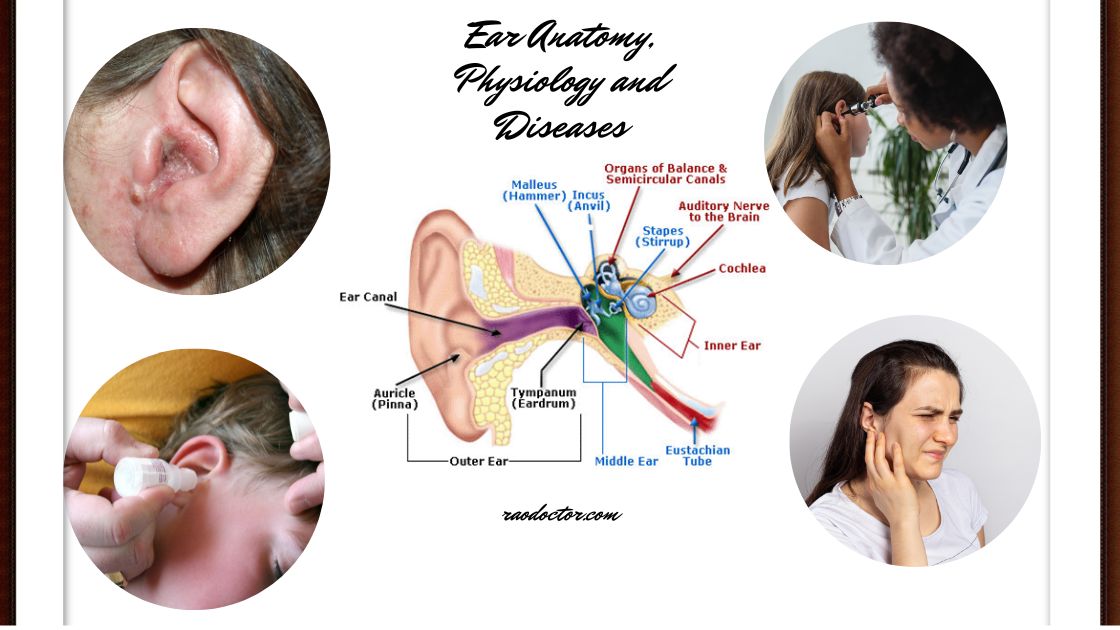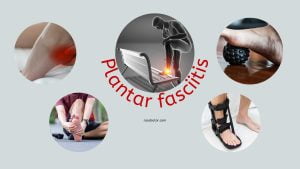In my last article, I described all about infections of the nose and throat. In this article we will learn all about the third component of the upper respiratory tract that is connected to the nose and throat- the ear.
Anatomy of the ear and functions of different parts
The ear is the organ of hearing and balance. It consists of three parts:
- the outer ear,
- middle ear, and
- inner ear.
It is very important to learn about these parts because today we are going to learn about the diseases affecting these parts.
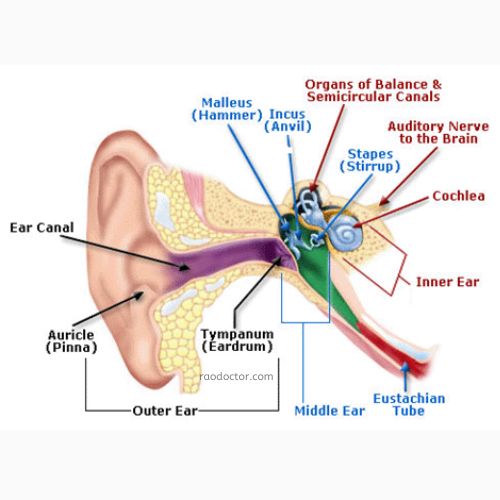
The outer ear includes the pinna (the visible part of the ear) and the ear canal.
The middle ear is separated from the outer ear by the eardrum and contains three small bones that amplify sound waves.
The inner ear contains the cochlea, which is responsible for hearing, and the vestibular system, which helps with balance.
Connecting the middle ear to the throat is a tube called the Eustachian tube. This tube is important because the infection of the throat and the nose can be transmitted to the middle ear causing an infection called Otitis Media.
Depending upon the site, there are three main types of ear infections:
- outer ear infections (otitis externa),
- middle ear infections (otitis media), and
- inner ear infections (otitis interna).
Let’s learn about these ear infections one by one-
Otitis externa:
This an infection of the outer ear canal that can cause pain and swelling.

Symptoms include:
- itching,
- pain,
- redness of the ear lobe [pinna], and
- discharge of pus with excoriation of the skin around the external ear canal.
Otitis media:
This is an infection of the middle ear that can cause pain and fever. Outer ear infections, also known as swimmer’s ear (otitis externa), occur when bacteria or fungi enter the ear canal through water exposure or cuts in the skin.
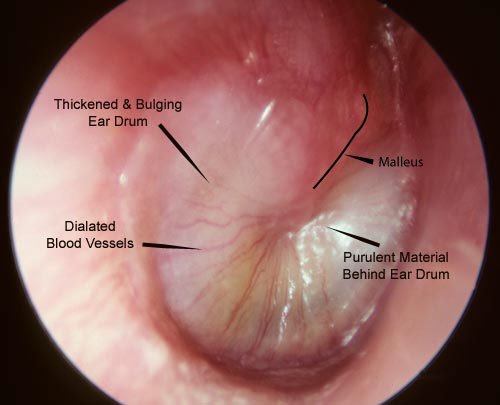
Middle ear infections (otitis media) are more common in children than adults and occur when fluid becomes trapped in the middle ear behind the eardrum.
Symptoms include
- pain, fever,
- temporary hearing loss, and
- a feeling of pressure or fullness in the ear.
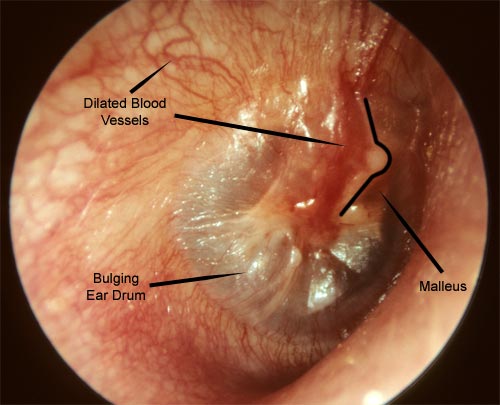
Here again, the middle ear infections are of two types: Acute Otitis Media [AOM] and Chronic Otitis Media [COM]
Acute Otitis Media [AOM]
Acute otitis media (AOM) is caused by bacteria or viruses and affects the middle ear. Symptoms and signs include-
- ear pain,
- fever,
- trouble hearing, and
- possibly pus drainage from the ear
Chronic Otitis Media
Chronic otitis media with effusion is a long-lasting buildup of fluid in the middle ear or occurs when fluid becomes trapped in the middle ear behind the eardrum. A possible cause of this condition is untreated or poorly managed AOM. The symptoms include:
- pain,
- fever,
- hearing loss, and
- a feeling of fullness in the affected year due to accumulated fluid/pus in the middle ear.
Useful Resource- Ear Infections
Otitis Interna
Inner ear infections (otitis interna) are the least common type, are rare and usually caused by a virus. Symptoms include
- vertigo [dizziness], sometimes hearing loss, and is called Meniere’s disease
- ringing or buzzing in the ear. This is called tinnitus.
What are ways or important investigations to diagnose ear infections?
Your attending doctor or ENT surgeon may advise to undergo these tests or investigations-
- Otoscopy: A physical examination of the ear canal and eardrum using a medical device called an otoscope. It helps the healthcare provider to detect any visible signs of infection, such as redness, swelling, or discharge. Learn all about this test here- Otoscopy
- Culture and sensitivity (C&S) test: A laboratory test performed on a sample of ear discharge or fluid to identify the specific type of bacteria causing the infection and determine the most effective antibiotic for treatment. Learn all about this test here- Culture and sensitivity test.
- Blood tests: These tests help to evaluate the overall health of the patient and detect any possible complications or underlying conditions, such as a weakened immune system.
- Imaging tests: These tests, such as a CT scan or an MRI, may be required if the ear infection is severe or chronic to determine the extent of damage and to rule out any other possible conditions.
- Tympanometry: A test that measures the movement of the eardrum in response to changes in ear pressure. This test helps to diagnose middle ear infections and determine the severity of the condition. Learn about this test here- Tympanometry
- Audiometry: A hearing test that evaluates the patient’s hearing ability, which may be affected in some cases of ear infections. Learn all about this test here– Audiometry.
For example:
Suppose a 10-year-old child complains of ear pain and fever for the last two days. Upon examination, the healthcare provider performs an otoscopy and identifies redness and swelling in the ear canal.
To confirm the diagnosis and determine the appropriate treatment, the provider orders a C&S test, blood tests, and tympanometry. If necessary, the provider may also conduct an imaging test to rule out any serious complications.
Ear Infections Signs and Symptoms in general
As you know by now, ear infections are common conditions that affect the middle ear, the part of the ear behind the eardrum that contains the tiny vibrating bones.
They can be caused by bacteria or viruses, and they often result from another illness, such as a cold, flu, or allergy, which causes congestion and swelling of the nasal passages, throat, and eustachian tubes².
The eustachian tubes are small tubes that run from each ear to the back of the throat. They help regulate air pressure, refresh air, and drain normal secretions from the middle ear. When the eustachian tubes become blocked, fluid can build up in the middle ear and become infected.
Ear infections can cause symptoms such as:
- Ear pain or discomfort
- Trouble hearing or responding to sounds
- Fever
- Drainage of fluid or pus from the ear
- Headache
- Loss of balance
- Nausea or vomiting
These symptoms may vary depending on the age of the person and the type of infection. Children are more likely than adults to get ear infections, and they may also show signs of fussiness, trouble sleeping, loss of appetite, or tugging or pulling at their ears.
These infections can be acute or chronic. Acute infections are painful but short in duration. Chronic infections either don’t clear up or recur many times. They can cause damage to the middle and inner ear, which can lead to hearing loss or other serious complications.
Management of Ear Infections
The treatment of ear infections depends on several factors, such as the cause, severity, and duration of the infection, as well as the age and health of the person. Some of these infections may clear up on their own without any treatment, while others may require antibiotics or other medications to fight the infection and reduce inflammation and pain.
Self-care and home remedies
Some home remedies that may help ease the symptoms of ear infections include:
- Applying a warm compress or heating pad to the affected ear
- Taking over-the-counter pain relievers such as ibuprofen or acetaminophen
- Using ear drops that contain olive oil, garlic, or hydrogen peroxide (only if the eardrum is not perforated)
- Elevating the head while sleeping to help drain fluid from the ear
- Drinking plenty of fluids to stay hydrated and thin mucus
However, these remedies are not substitutes for medical advice and should not be used without consulting a doctor first. If you have any signs of an ear infection, especially if they are severe or persistent, you should see a doctor as soon as possible for proper diagnosis and treatment.
Useful Resource: Natural Ear Infection Remedies
Prevention of Ear infection
Some ways to prevent ear infections include:
- Avoiding exposure to tobacco smoke and other irritants that can affect the respiratory system
- Washing your hands frequently and avoiding contact with people who are sick
- Breastfeeding infants for at least six months if possible
- Keeping up to date with vaccinations that can protect against common causes of ear infections
- Avoiding inserting anything into your ears, such as cotton swabs, fingers, or foreign objects
- Treating any allergies or sinus problems that may affect your ears
Medical line of treatment of ear infections
Warning– the information given below is only meant to improve your knowledge on the treatment of ear infections and is not to be considered as a prescription for treatment. Your healthcare provider/ doctor is the best person to help you get better.
- Antibiotics are often prescribed for bacterial ear infections such as acute otitis media (AOM).
Example: Amoxicillin, Augmentin, Cefdinir, Cefuroxime, Cefpodoxime, Azithromycin, Clarithromycin, Levofloxacin, Moxifloxacin, etc. - Over-the-counter pain relievers like acetaminophen (Tylenol) or ibuprofen (Advil) can help relieve ear pain and inflammation.
Example: Tylenol, Advil, Aleve, etc. - Decongestants can help relieve congestion and pressure in the ear.
Example: Sudafed, Afrin, Phenylephrine, etc. - Antihistamines can help relieve allergy-related ear infections.
Example: Claritin, Zyrtec, Allegra, etc. - Steroids such as prednisone or methylprednisolone can help reduce inflammation.
Example: Prednisone, Methylprednisolone, etc. - Surgery may be necessary for chronic or severe ear infections that don’t respond to other treatments.
Example: Myringotomy, Tympanoplasty, Mastoidectomy, etc. - Ear tubes may be inserted to drain fluid and allow for equalization of pressure in the ear.
Example: Tympanostomy tubes, ventilation tubes, etc.
It’s important to note that not all ear infections require medication or surgery. Some ear infections may resolve on their own over time. It’s recommended to consult with a healthcare professional for proper diagnosis and treatment options.
Useful article: All about ear
Conclusion
I hope this information was helpful and informative. If you have any more questions about ear infections or anything else, feel free to ask me. 😊
If you have found this article useful, do consider sharing it with your friends and family members on social media by clicking on the icons at the bottom of this article. Alternately, you can Click to Tweet below-
Learn all about your ear- it’s anatomy, physiology and diseases Share on XMy next article will be on some conditions that I have already mentioned in this article-Tinnitus and Meniere’s disease.

